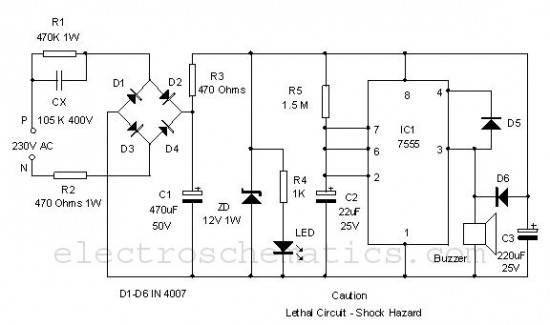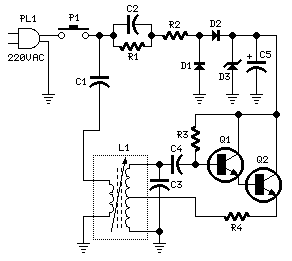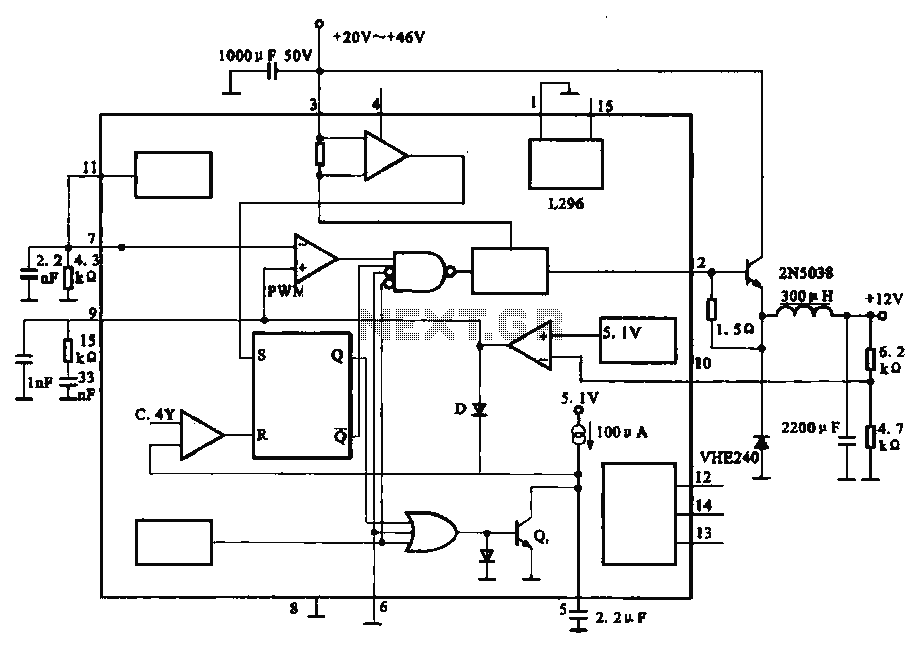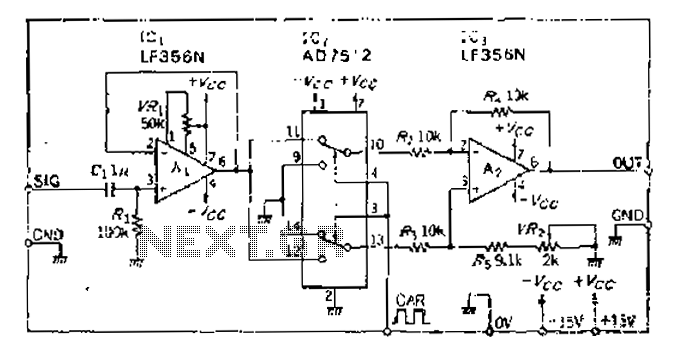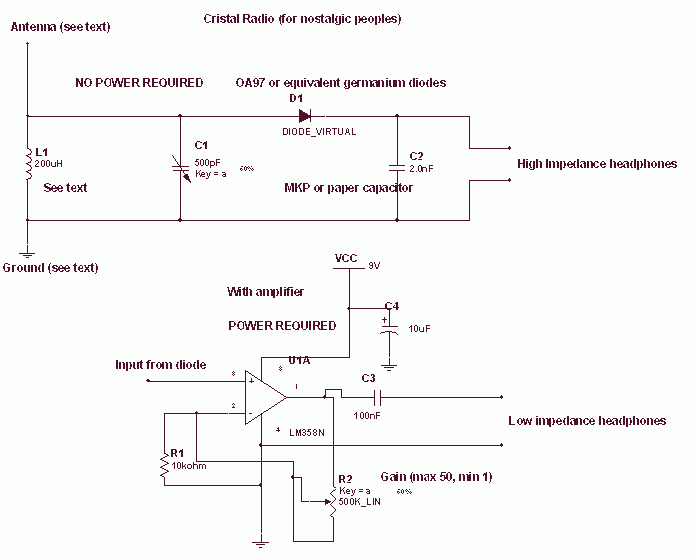
one tube regen radio circuit
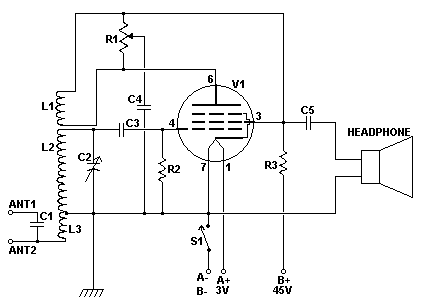
A regenerative radio operates by feeding back a small portion of the amplified output from the detector into the input. This feedback mechanism enhances sensitivity significantly beyond what a detector can achieve on its own. The simple regenerative radio described utilizes a single tube as both the detector and amplifier, known as the "Audion." It serves as an excellent introductory project for individuals interested in constructing one of the earliest amplified radio sets. Built on a board using point-to-point wiring and a set of period headphones, this radio can also function as an engaging conversational piece. Coils L1 to L3 are made using the same coil form, which can be a toilet paper tube. To create the coils, secure a length of 26 AWG wire to the tube by punching two close holes and winding the wire around the bridge between them, or alternatively, use a drop of hot glue. Leave approximately 6 inches of wire free. Wind twenty turns tightly together without overlapping to form L3, securing the wire with glue to create a tap. Continue by winding an additional 80 turns in the same direction to form L2, again leaving a 6-inch lead. For L1, secure the wire 1/8 inch from the end of L2 and wind 30 turns, ensuring it is spaced evenly 1/8 inch away from L2. After trimming the coil form's excess length, spray the coils with several coats of lacquer to secure the wires. Resistor R1 and switch S1 can be combined into a single unit by using a potentiometer with an integrated switch, preventing the set from being turned on at full regeneration, which could cause a loud squeal in the headphones. An antenna of a few feet can be used for ANT1 for indoor use, but a more effective option is an outdoor antenna of 50 feet or longer, connected to ANT2. To operate the radio, set capacitor C2 to the midpoint, turn resistor R1 fully counterclockwise, and activate switch S1, allowing the tubes to warm up for several seconds. Gradually increase R1 until the headphones emit a squeal, then reduce it slightly to achieve maximum sensitivity. Tune capacitor C2 to the desired frequency, adjusting R1 as necessary when changing stations. With practice, the user will learn to manage the regeneration level needed for different frequencies.
The regenerative radio circuit is a classic example of early radio technology, leveraging feedback to enhance signal reception. The Audion tube serves as the heart of the circuit, functioning both as the detector and amplifier, which allows for the amplification of weak radio signals. The design's simplicity makes it accessible for hobbyists and electronics enthusiasts.
The construction of the coils (L1, L2, and L3) is critical for the performance of the radio. The use of a toilet paper tube as a coil form is a practical and cost-effective choice, with the 26 AWG wire providing sufficient inductance. The precise winding of the coils is essential; overlapping turns can lead to inefficient coil performance and reduced sensitivity. The tap on L3 is particularly important as it allows for feedback to be fed back into the circuit.
The combination of R1 and S1 into a single unit is a thoughtful design choice. It not only simplifies the circuit layout but also enhances user safety by preventing accidental full regeneration, which could damage the headphones or create an unpleasant experience. The selection of antennas is also crucial; while a short indoor antenna may suffice for testing, a longer outdoor antenna significantly improves reception quality, allowing for clearer and more stable sound.
Overall, this regenerative radio project encapsulates the fundamental principles of radio technology, including signal amplification, feedback mechanisms, and tuning, making it an excellent educational tool for understanding the basics of radio electronics.A regenerative radio works by feeding back a small amount of amplified output of the detector back into the input. Thus it achieves sensitivity far beyond what only a detector could alone. This simple regen radio uses a single tube as it`s detector and amplifier; the "Audion". It`s a great first project for those wishing to bring back some nostalg ia by building one of the first amplified radio sets. Built on a board using point to point wiring and a set of period headphones, it can be a great functional conversation piece. L1 - L3 are constructed on the same coil form. A toilet paper tube will be the coil form. Secure the 26 AWG wire to the form by punching two holes close together and winding the wire once around the "bridge" between them.
Alternately, just a drop of hot glue can be used. Leave about 6" of wire. Wind on twenty turns close together but never overlapping. Make a tap by securing the wire with a drop of glue and twisting a loop. This is L3. Wind 80 more turns in the same direction and then secure the end, leaving about 6" of wire at the end. This is L2. Now secure the 26 AWG wire 1/8" from the end of L2 and wind 30 turns in the same direction as the other coils, making sure that this coil is spaced 1/8" evenly from L2.
Secure the end and leave about 6" lead. This is coil L1. Now trim the extra length of the coil form and spray the coil with several coats of lacquer to hold the wires in place. R1 and S1 can be one unit if you purchase a pot with a built in switch. This will avoid turning the set on with full regen and causing a nasty squeal from the headphones. An antenna of only a few feet can be used for ANT1 for easy indoor installation. Far better is an antenna of 50 feet or more outside, which would be connected to ANT2. To use the set, place C2 at about midway, set R1 fully counterclockwise and then turn on S1 and allow the tubes several seconds to warm up.
Increase R1 until the headphones squeal, then back off. That is when the set is most sensitive. Now tune C2 to the desired frequency. You may have to readjust R1 as you tune different frequencies. With some practice you will figure out how much regen you need as you change stations. 🔗 External reference
The regenerative radio circuit is a classic example of early radio technology, leveraging feedback to enhance signal reception. The Audion tube serves as the heart of the circuit, functioning both as the detector and amplifier, which allows for the amplification of weak radio signals. The design's simplicity makes it accessible for hobbyists and electronics enthusiasts.
The construction of the coils (L1, L2, and L3) is critical for the performance of the radio. The use of a toilet paper tube as a coil form is a practical and cost-effective choice, with the 26 AWG wire providing sufficient inductance. The precise winding of the coils is essential; overlapping turns can lead to inefficient coil performance and reduced sensitivity. The tap on L3 is particularly important as it allows for feedback to be fed back into the circuit.
The combination of R1 and S1 into a single unit is a thoughtful design choice. It not only simplifies the circuit layout but also enhances user safety by preventing accidental full regeneration, which could damage the headphones or create an unpleasant experience. The selection of antennas is also crucial; while a short indoor antenna may suffice for testing, a longer outdoor antenna significantly improves reception quality, allowing for clearer and more stable sound.
Overall, this regenerative radio project encapsulates the fundamental principles of radio technology, including signal amplification, feedback mechanisms, and tuning, making it an excellent educational tool for understanding the basics of radio electronics.A regenerative radio works by feeding back a small amount of amplified output of the detector back into the input. Thus it achieves sensitivity far beyond what only a detector could alone. This simple regen radio uses a single tube as it`s detector and amplifier; the "Audion". It`s a great first project for those wishing to bring back some nostalg ia by building one of the first amplified radio sets. Built on a board using point to point wiring and a set of period headphones, it can be a great functional conversation piece. L1 - L3 are constructed on the same coil form. A toilet paper tube will be the coil form. Secure the 26 AWG wire to the form by punching two holes close together and winding the wire once around the "bridge" between them.
Alternately, just a drop of hot glue can be used. Leave about 6" of wire. Wind on twenty turns close together but never overlapping. Make a tap by securing the wire with a drop of glue and twisting a loop. This is L3. Wind 80 more turns in the same direction and then secure the end, leaving about 6" of wire at the end. This is L2. Now secure the 26 AWG wire 1/8" from the end of L2 and wind 30 turns in the same direction as the other coils, making sure that this coil is spaced 1/8" evenly from L2.
Secure the end and leave about 6" lead. This is coil L1. Now trim the extra length of the coil form and spray the coil with several coats of lacquer to hold the wires in place. R1 and S1 can be one unit if you purchase a pot with a built in switch. This will avoid turning the set on with full regen and causing a nasty squeal from the headphones. An antenna of only a few feet can be used for ANT1 for easy indoor installation. Far better is an antenna of 50 feet or more outside, which would be connected to ANT2. To use the set, place C2 at about midway, set R1 fully counterclockwise and then turn on S1 and allow the tubes several seconds to warm up.
Increase R1 until the headphones squeal, then back off. That is when the set is most sensitive. Now tune C2 to the desired frequency. You may have to readjust R1 as you tune different frequencies. With some practice you will figure out how much regen you need as you change stations. 🔗 External reference

